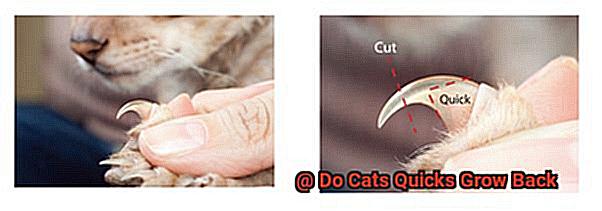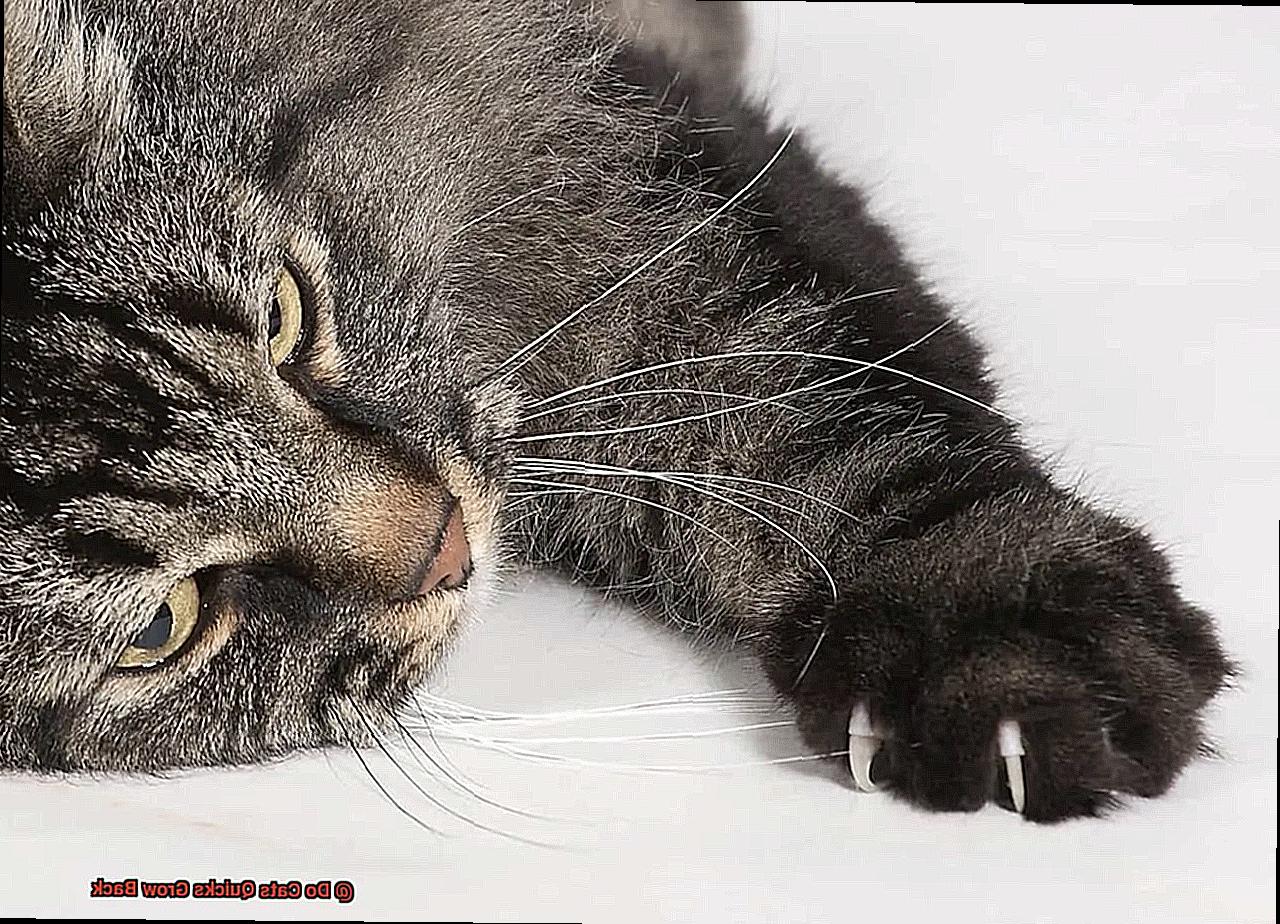Hey there, fellow cat lovers. Have you ever experienced that heart-wrenching moment when you accidentally cut your kitty’s claws too short and exposed a tiny pink spot known as the quick? As a proud feline enthusiast, I can relate to the panic that comes with wondering whether your cat’s quick will grow back or not.
In this blog post, we’ll delve into the fascinating world of cats’ claws and demystify the enigmatic quick. We’ll explore whether or not quicks grow back and provide practical tips on what to do if you’ve clipped into it.
But wait, there’s more. We’ll also uncover intriguing facts about cat claws such as why they sharpen their claws and why some cats have retractable claws while others don’t.
So grab a cup of coffee (or tea) and settle in for an informative yet engaging read on the incredible anatomy and biology of cats’ claws. By the end of this article, you’ll be able to confidently answer the age-old question: do cats’ quicks grow back?
Can Cat Quicks Grow Back?
The answer is a resounding yes. But, as with any injury, proper care and attention are essential for a smooth recovery.
The quick is the pink, sensitive area of your cat’s nail that contains nerves and blood vessels. Accidentally cutting it can cause pain, bleeding, and discomfort for your feline friend. However, the good news is that the quick is not gone forever. It just needs time to regenerate.
It’s important to note that the regeneration process can take several weeks to months, depending on the individual cat and how much of the quick was removed. During this time, it’s crucial to monitor your cat’s paws for any signs of infection or discomfort.
If you do accidentally cut your cat’s quick, the first step is to stop the bleeding by applying pressure to the nail with a clean cloth. Then, soak your cat’s paw in warm water to clean the area and prevent infection. This will help soothe your cat and reduce any discomfort.

It’s essential to avoid cutting too close to the quick in future nail trimmings. Cutting too close can cause pain and trauma to your cat’s paw, making it more difficult for the quick to grow back properly. It’s recommended to leave a small amount of space between the quick and where you cut. Your cat will thank you.
If you notice any signs of infection or discomfort during the regrowth process, seeking veterinary care is crucial. Your veterinarian can assess the extent of the damage and provide proper treatment to promote healing and prevent further complications. In some cases, surgical intervention may be necessary.
How Long Does it Take for a Cat Quick to Regrow?
The rate at which a cat’s quick regrows can vary depending on several factors, such as age, health, and diet. Typically, it takes about four to six weeks for a cat’s quick to fully regrow after being injured or trimmed. However, some cats may take longer to heal.
Younger cats usually have faster-growing nails, so their quicks tend to regrow faster. Moreover, cats who consume a healthy diet rich in protein and nutrients may also experience quicker nail growth, which can aid in speeding up the healing process.
While your cat’s quick will eventually regrow after being injured or trimmed, it is crucial to be cautious when trimming their nails in the future. Regular nail trims can prevent the quick from growing too long and getting injured again. If you are uncertain about how to safely trim your cat’s nails, it is best to consult with a veterinarian or professional groomer.
During the healing process, it is essential to keep a close eye on your cat’s paws for any signs of infection or discomfort. By providing proper care and attention, you can ensure that your feline friend’s nails stay healthy and strong.
What Happens When a Cat’s Quick is Cut Too Short?
Regular nail trimming is a crucial part of this, but it’s essential to be cautious when cutting their nails. Accidentally cutting the quick, the pinkish part of the nail that contains blood vessels and nerves, can be a painful and traumatic experience for your cat.

When the quick is cut too short, it can cause bleeding, pain, and infection. In severe cases, it may even require medical attention from a veterinarian. Your cat may also react aggressively or become fearful of future nail trimming sessions. Moreover, it can take several weeks or even months for the quick to fully heal during which your cat may experience pain and discomfort while walking or using their paws. They might also be more prone to infections and other complications.
However, don’t lose hope. With proper care and attention, your cat’s quick will eventually grow back. It may take time for the quick to fully regrow, but most cats will recover fully from a shortened quick. The new quick may be shorter than the original one, so it’s crucial to be extra careful when trimming your cat’s nails in the future.
If you accidentally cut your cat’s quick too short, it’s essential to remain calm and provide them with proper care and attention to ensure they heal properly. Using styptic powder or cornstarch can stop bleeding, while keeping the paw clean and dry can prevent infection.
Remember, accidents happen. Don’t feel guilty if you accidentally injure your cat’s quick. Instead, show them patience and love during the healing process. Your furry friend will forgive you in no time.
How to Trim a Cat’s Nails Safely
Trimming your cat’s nails may seem like a daunting task, but it’s an essential part of maintaining their hygiene and preventing damage to your furniture and other household items. However, it’s important to approach this task with caution to avoid damaging the quick – the sensitive pink part of the nail that contains blood vessels and nerves. To help you safely trim your cat’s nails, we’ve put together these tips:
Acclimate Your Cat
Before trimming your cat’s nails, introduce them to having their paws touched and handled. Try gently touching and massaging their paws while providing treats to create a positive association.
Use The Right Tools
It’s crucial to use the correct tools for trimming your cat’s nails. Sharp and sturdy nail clippers specifically designed for cats will ensure a clean cut without hurting your cat.
Locate The Quick
The quick is the pink area inside the nail that contains blood vessels and nerves. Be sure to identify the quick before you start trimming and avoid cutting into it, which can cause pain and bleeding.
Take It Slow
Make small cuts at a slight angle to avoid hitting the quick. If you have difficulty identifying the quick in dark nails, make small cuts until you see a black dot in the center of the nail. Remember, it’s better to make several small cuts than one big one.
Stop Bleeding
If you accidentally cut into the quick, don’t panic. Apply styptic powder or cornstarch to stop any bleeding, and provide plenty of praise and treats to reassure your feline friend.
By following these tips, you can ensure that your cat’s nails are healthy and prevent any accidental injuries during the trimming process. Plus, with regular grooming and care, you can gradually trim your cat’s nails closer to the desired length without risking injury to the quick. So, grab those clippers, some treats, and get ready to give your furry friend a paw-dicure.

What if a Cat’s Quick Becomes Damaged or Infected?
However, accidents can still happen, and if your cat’s quick becomes damaged or infected, it can be a painful and uncomfortable experience for them. The quick is the pink part of the nail that contains blood vessels and nerves, serving as a protective layer for their toe bone. If it becomes damaged or infected, it can cause bleeding, pain, inflammation, and even lead to more serious problems if left untreated.

If your cat’s quick becomes damaged due to injury or trauma, taking action is crucial. First, apply pressure to the affected area with a clean cloth or gauze. If the bleeding persists after 10 minutes, it’s time to take your cat to the veterinarian for proper care. In some cases, a damaged quick may need to be removed surgically under anesthesia to prevent further complications.
If you notice that your cat’s quick appears red, swollen, and emits a foul smell, it could be infected. Seeking veterinary care immediately can prevent the infection from spreading. Treatment for an infected quick may include antibiotics or antifungal medication, depending on the type of infection. In severe cases, surgery may be necessary to remove the affected nail and surrounding tissue.
As a responsible pet owner, it’s essential to monitor your cat’s progress and follow any post-treatment instructions provided by your veterinarian. With proper care and treatment, most cats will make a full recovery and regrow their quicks.
Prevention is always better than cure. Regular nail trimming can help prevent damage to the quick and keep your cat healthy and happy. Consult with your veterinarian or a professional groomer if you’re unsure how to properly trim your cat’s nails.
Prevention and Treatment of Damaged or Infected Quicks
One of the most crucial aspects of caring for your cat is preventing and treating damaged or infected quicks. These painful injuries can cause severe discomfort and even lead to serious health issues if left untreated. But don’t worry, we’ve got you covered with some essential tips on how to keep your cat’s paws healthy and pain-free.
Regular nail trimming is key to preventing damaged or infected quicks in cats. We recommend trimming your cat’s nails every 2-3 weeks using specialized cat nail clippers. This is especially important for indoor cats who don’t have the opportunity to wear down their nails naturally. By keeping their nails short, you can minimize the risk of them getting caught on surfaces and injuring their paws.
If you do happen to notice a damaged or infected quick, don’t wait – seek veterinary help immediately. Your vet will be able to assess the extent of the injury and provide appropriate treatment, which may include antibiotics, pain relief medication, and in some cases, removal of the affected nail.
In addition to seeking professional help, there are some home remedies that can help alleviate the pain and discomfort associated with damaged or infected quicks. Applying a warm compress to the affected area can help reduce swelling and promote healing. Soaking your cat’s paw in warm water with Epsom salt, which has anti-inflammatory properties, can also be beneficial.
Preventing damaged or infected quicks also involves ensuring that your cat’s environment is free from potential hazards. Keeping their litter box clean can prevent infections from developing in their paws. Providing them with appropriate scratching posts can also prevent them from scratching on furniture or other surfaces, which can lead to damaged nails.
Conclusion
In conclusion, cat lovers can breathe a sigh of relief knowing that their beloved feline’s quicks do grow back after an accidental snip. However, it’s important to note that proper care and attention are crucial for a smooth recovery. Keep a watchful eye on your cat’s paws during the regeneration process, which can take several weeks or even months.
To avoid any future mishaps, make sure to leave a small gap between the quick and where you cut during nail trimmings. Regular nail trims are also essential in preventing the quick from growing too long and becoming susceptible to injury.
In the event of a damaged or infected quick, seeking veterinary care immediately is paramount. Remember, prevention is always better than cure. So don’t wait until it’s too late – invest in specialized cat nail clippers and make regular nail trimming part of your furry friend’s grooming routine.
By following these tips and giving your feline friend some well-deserved paw-dicures, you’ll be ensuring their paws stay healthy and pain-free.







